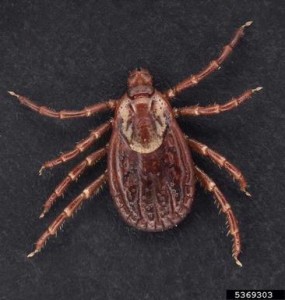Creating a Tick-Free Zone in Your Yard – Advice From the Pros
By Chris Williams on May 19, 2015.

An American Dog Tick
Many people don’t realize that they can prevent ticks in ways other than wearing repellent and protective clothing. No only can you have your property treated by a professional exterminator, but there are steps you can take in the management of your property that will make it less attractive to ticks (see Ticks Should Be Controlled Outside, in Your Yard).
If you have a wooded lot, you probably already know that your yard is a hotbed for ticks, largely because deer, rodents, and other wildlife visit your property. But don’t despair, and don’t chop down your trees. Spend a weekend making some simple changes to your property and lower your family’s risk of tick bites and disease.
Basic Yard Cleanup –
The more clean, open space around your home, the less likely you will be bitten by a tick. When ticks are looking for a host to attach to, they climb plants and shrubs and wait for an animal to pass by. Remove tall weeds and brush, and prune shrubs to let in more light. Rake fallen leaves since ticks often spend the winter under leaf litter and leaves provide cover for burrowing rodents.
Remove Rodent Shelter and Food –
Deer and smaller animals like mice and chipmunks are hosts for many of the ticks that spread disease. While it’s harder to keep deer off of your property, you can eliminate some of the attractions for mice, voles, and chipmunks. These rodents like to nest in woodpiles, debris piles, and stonewalls. Remove or move such piles away from your home. Avoid the use of dense groundcovers like pachysandra that hide rodent burrows.
Get rid of rodent food, too, by removing or relocating bird feeders. Clean up spilled seed regularly from under bird feeders. Pick up fallen or rotting produce from your garden or fruit trees.
Landscaping and Lawn Management –
Choose plantings that do not attract deer. Keep grass mowed and mow wildflower fields in the fall. Move children’s play areas and play equipment away from woods’ edges. Use more hardscaping, like pathways of gravel or tile, and fewer plantings in your yard. Turn frequent lawn travel routes of people and pets into pathways instead of grass.
Install an Edge Border –
Pay special attention to the edges of your property where lawn meets woods. This is where ticks are most often found. Remove leaf litter, brush, and weeds in this perimeter. Trim tree branches and shrubs at this edge zone to let in more air and light, and widen woodland paths so people don’t brush against vegetation. Install a 3-foot wide border of wood chips, mulch, or gravel between your lawn and the woods.
Call Colonial Pest –
Have a professional exterminator inspect your property and treat high risk tick areas and edge zones in your yard. If rodents are a problem in your yard, we can set up a management program to eliminate them as well. Give us a call today.